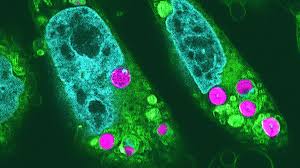Revolutionary Research: Algal Chloroplasts Enable Photosynthesis in Hamster Cells

A groundbreaking study from Japan reveals that chloroplasts from algae have been successfully integrated into hamster cells, allowing these animal cells to photosynthesize light. Previously, researchers believed that the combination of chloroplasts—structures in plants and algae that contain chlorophyll—with animal cells was not feasible, as it was thought that chloroplasts would either not survive or would not function properly within the animal cells. However, the results demonstrated that photosynthetic activity persisted for at least two days after integration.
This innovative technique holds promise for advancements in artificial tissue engineering. One of the challenges faced in tissue growth is oxygen deprivation, which can hinder development. By incorporating chloroplast-infused cells, it may be possible to supply energy and oxygen through light exposure and photosynthesis.
Imagine a world where you could harness the power of the sun to fuel your energy needs, akin to how plants and algae do. While this may sound like something out of science fiction, some animals, like giant clams, have already established symbiotic relationships with algae. In this arrangement, the algae, equipped with chloroplasts, photosynthesize to produce food and oxygen, while the clams provide shelter for the algae.
Professor Sachihiro Matsunaga from the University of Tokyo, the corresponding author of the research paper, stated, "As far as we know, this is the first reported detection of photosynthetic electron transport in chloroplasts implanted in animal cells." Photosynthetic electron transport is vital for generating chemical energy, which supports numerous cellular functions in plants and algae. Professor Matsunaga added, "We initially thought that the chloroplasts would be digested by the animal cells within hours, but our findings showed they continued to function for up to two days, demonstrating active electron transport and photosynthesis."
In their experiments, the researchers inserted chloroplasts from red algae into cultured hamster cells. They utilized various imaging techniques, including confocal microscopy, superresolution microscopy, and electron microscopy, to examine the structure of the chloroplasts within the cells. Additionally, they confirmed photosynthetic electron transport through pulses of light using a technique known as pulse amplitude modulation fluorometry.
Matsunaga noted, "This work has significant implications for cellular tissue engineering. Lab-grown tissues, including artificial organs and meat, often struggle to grow due to hypoxia, which limits cell division. Introducing chloroplast-implanted cells could facilitate oxygen supply through photosynthesis, improving conditions for cell growth."
The research team is focused on developing what they refer to as "planimal" cells, which aim to combine beneficial features of plants with those of animals. The study found that animal cells containing chloroplasts exhibited increased growth rates, indicating that chloroplasts provided a carbon source for the host cells. Future research may explore substance exchange processes between host cells and chloroplasts and identify additional byproducts generated from this interaction.
Matsunaga expressed optimism for the future of planimal cells, stating, "We expect these cells to be transformative, aiding in our transition to a more carbon-neutral society. Our ongoing research aims to develop innovative biotechnologies that support sustainable living and reduce carbon dioxide emissions."
Story Source:
Materials provided by University of Tokyo. The original text of this story is licensed under a Creative Commons License. Note: Content may be edited for style and length.
Journal Reference:

0 Comments